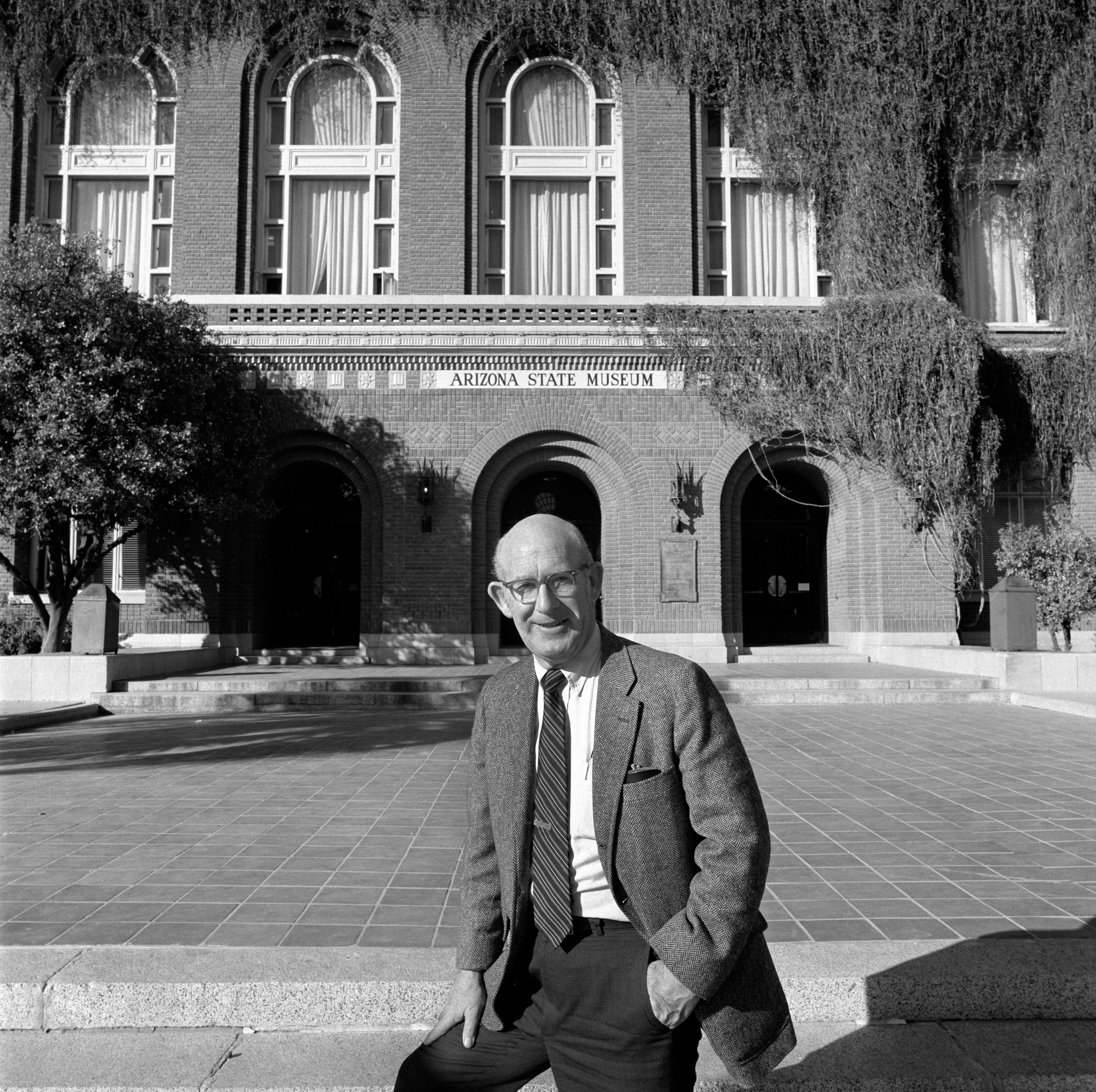Article begins

Image description: A man wearing glasses, a striped tie, and suit poses with one hand resting on his leg and the other in his pocket. Behind him, a brick and stone building stands with high arched windows, partially covered in ivy. Above the building entrance text reads “Arizona State Museum.”
Caption: Raymond Harris Thompson
1924–2020
Raymond Harris Thompson Jr., who was born May 10, 1924, in Woodford, Maine, died January 29, 2020, in Tucson, Arizona. Most of his 50-year career was devoted to guiding the growth of archaeology, anthropology, and museology nationally and at the Arizona State Museum (ASM) and the Department of Anthropology at the University of Arizona (UA).
In 1942, Thompson enrolled in Tufts University, on a full scholarship, to study geology. Drafted in 1944, he was assigned to a Seabee construction battalion detachment and sent to Iwo Jima to help build airstrips and other facilities after the island was secured. Returning to Tufts after the war, he fulfilled a field school requirement by attending the UA Point of Pines Field School in archaeology, under the direction of Emil W. Haury.
Thompson began graduate studies at Harvard University in February 1948 with G. I. Bill benefits. While completing his dissertation in 1952, he accepted a job at the University of Kentucky as the curator of the Museum of Anthropology and an assistant professor of anthropology, where he worked for four years.
He accepted a position at UA in 1956 to teach introductory anthropology and various archaeology courses. After Haury’s 1964 retirement, Thompson served for 16 years as the third director of the ASM and the third head of the Department of Anthropology, following in the footsteps of Byron Cummings and Haury. From 1980 until his retirement in 1997, Thompson was the director of the ASM and the Fred A. Riecker Distinguished Professor of Anthropology.
Thompson made important legislative contributions to current archaeological practice both nationally and in Arizona. In 1978, he and a small number of colleagues drafted and successfully lobbied for the Archaeological Resources Protection Act. Thompson delivered the final consensus draft of the legislation to Representative Morris Udall, who introduced it in the US House of Representatives. He later testified for the act in front of the relevant House and Senate subcommittees in 1979. Importantly for the practice of archaeology in the state of Arizona, in 1983 he obtained major revisions to the State Antiquities Act that allowed the creation of private contract archaeological firms, thus supporting development of the industry through which most Arizona archaeology is done today.
In 1990, Thompson supported another amendment to the State Antiquities Act, requested by Arizona’s tribal community, to promote state repatriation and reburial of human remains. Later that same year he went before the Interior Committee of the US House of Representatives to address the contents of the bill that would later become the landmark legislation known as the Native American Graves Protection and Repatriation Act.
Thompson received numerous awards and honors during his illustrious career, including the American Anthropological Association Distinguished Service Award in 1980, the Society for American Archaeology Fiftieth Anniversary Service Award in 1985, and the Arizona Archaeological and Historical Society Byron Cummings Award in 1993. In recognition of its 90th anniversary, the UA Department of Anthropology established the Raymond H. Thompson Award in his honor. In 2019, UA named the ASM’s main building the Raymond H. Thompson Building in honor of his legacy. Thompson was a noted doggerelist, creating, seemingly on the spur of the moment, rhyming verse in English, Spanish, or German, right up to the last month of his life.
Thompson’s beloved wife, Molly Kendall Thompson, died in 2014. She and Ray Thompson are survived by two daughters, Margaret Luchetta of Danjoutin, France, and Mary Thompson of Tigard, Oregon; Margaret’s husband, Georges Luchetta; two granddaughters; and two great-grandchildren.
(Beth Grindell)
Cite as: Grindell, Beth. 2020. “Raymond Harris Thompson .” Anthropology News website, August 14, 2020. DOI: 10.14506/AN.1473

